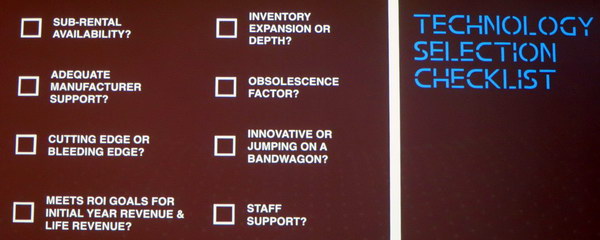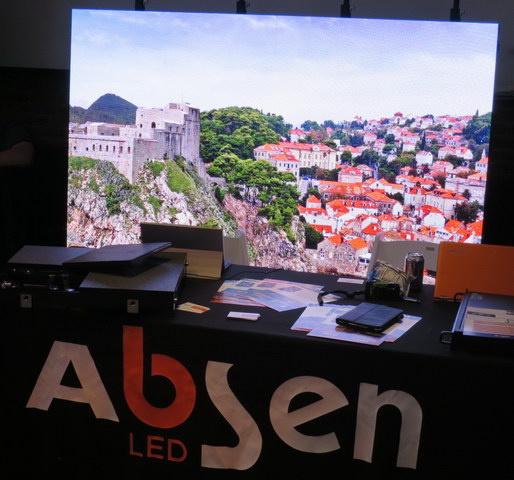I went to the Rental and Staging Roadshow in New York on August 2nd and will write a complete report for the upcoming Large Display Monitor (subscription required). Josh Weisberg, President of WorldStage, one of the major sponsors of the Roadshow, was the keynote speaker and talked about “Managing Change in a Technology-Driven Industry – What I learned on Broadway.” According to Weisberg, changes in technology in the rental and staging market are happening at light-speed.

Weisberg said evolution is taking place on multiple fronts – audio, video and lighting. Changes in video include image acquisition, editing for both real-time display and later off-line use, video control and routing and video display technology. He added that, unlike most people currently working in the rental and staging industry, he could remember when hardware didn’t require a firmware update – you took it out of the box and it worked as intended for the life of the product.
 Josh Weisberg talked about “Managing Change in a Technology-Driven Industry” at the Rental and Staging Roadshow (Credit: M. Brennesholtz)
Josh Weisberg talked about “Managing Change in a Technology-Driven Industry” at the Rental and Staging Roadshow (Credit: M. Brennesholtz)
One of the major issues for a rental and staging company like WorldStage is deciding what equipment to buy and keep in inventory against the needs of future rental and sub-rental customers. For projectors, perhaps the issue may be Christie vs Barco vs Panasonic vs DP. And don’t forget Epson which is moving into this market. For servers and connectivity, perhaps the question is Analog Way vs Barco vs Christie.
But there is no aspect of rental and staging technology that presents a more bewildering variety of choices to the purchaser than LED video walls, which have taken on a dominant position in displays used at these events. According to Weisberg, it is “DigiLED vs InfiLED vs Unilumin vs CreateLED vs Aoto vs ROE vs Absen vs Oracle vs Glux vs Gtek vs Coleder vs Vteam vs YesTech vs Gloshine vs ‘Shenzen Mary Photoelectricity LTD’????????”
I had to look up Shenzen Mary Photoelectricity to make sure Weisberg wasn’t making up a company name as a joke and a commentary about the ease of entry into this market. He wasn’t and the company describes itself as “Shenzhen Mary Photoelectricity Co., Ltd (MRLED) is a subsidiary of state owned listed company – Fujian FURI Electronics Co., Ltd, was established in April, 2006 with registered capital 100 Million RMB (around $16 million). MRLED is a national-level high-new technology enterprise which specializes in designing, researching, manufacturing and selling all kinds of LED displays.” The company is said to be one of the top 10 LED screen manufacturers in Shenzhen, China.
 A few of the many, many direct view LED videowall manufacturers at ISE 2017. (Credit: M. Brennesholtz)
A few of the many, many direct view LED videowall manufacturers at ISE 2017. (Credit: M. Brennesholtz)
At ISE last February, Bob Raikes and I visited and wrote about for the ISE Special Report (Subscription required) a total of 33 different manufacturers of LED videowall modules and the two of us didn’t have the time to visit anywhere near all the manufacturers present. Bob had been told that there were about 160 Shenzhen-based LED companies alone at the show! Weisberg said during his talk that any EE in Shenzhen with a 3D printer can call himself a LED videowall module manufacturer. While I suspect that’s an exaggeration, I also suspect it looks like the truth to a US-based rental and staging company trying to select a new series of videowall modules to add to it’s inventory.*
The fine-pitch videowall modules (0.7mm – 2mm) grab a lot of the headlines and often are highlighted in manufacturers’ booths at shows like ISE or InfoComm. However, these don’t represent the sweet spot of the rental and staging market. In this market, the viewers are commonly relatively far away from the displays and the sweet spot is in the 7mm – 9mm pitch range. There is a growing place for these fine-pitch displays in the rental and staging market but it isn’t facing the show attendees. Instead, small arrays of these modules are replacing LCD displays facing the performers and presenters on stage. The high brightness possible and ruggedness of the LED modules makes them especially attractive in outdoor events such as music festivals.
So how should a rental and staging company select the supplier of the next generation of LED modules to purchase? One thing you should not do is select the company that has the salesmen that are the best at schmoozing. Everybody knows this is a bad idea but it’s still done anyway. Weisberg says to be democratic and involve all the stakeholders in the rental and staging company. His recommended steps are:
- Identify the stakeholders – product managers, field techs, operations managers, sales executives with big LED clients and finance.
- Identify the different types of products that are purchase options.
- Identify vendors and asses their level of “commitment” and identify potential sub-rent allies for each product.
- Arrange shop demos for ALL products under consideration and make sure the stakeholders have a “hands-on” opportunity.
- Create a detailed, accurate financial worksheet that includes costs, estimated revenue and operational expense of all products being considered. Compare estimated monthly [revenue] to expected carrying cost (maintenance, principal and interest).
- Create a simple summary of the products, less any that didn’t make the cut.
- Have stakeholders vote on their top three based on level of enthusiasm and score the products on a graduated scale (ex: #1 choice is 3 points, #2 is 2 points, etc.)
- Tally the response and see if there are serious detractors.
 Weisberg’s Technology Selection Checklist for LED videowalls and other technology items for a rental and staging company. (Credit: WorldStage)
Weisberg’s Technology Selection Checklist for LED videowalls and other technology items for a rental and staging company. (Credit: WorldStage)
Weisberg warned there are a couple “Gotchas” in this process. For Item #4 in the list, he said that any company that is unwilling to let you have samples to test in your own facility should be dropped from the list, no matter how many promises the salesmen make or how good their modules look on paper or at a trade show like ISE. For item #5, he said to be careful about estimating revenue – rents for LED videowalls have been coming down. Also, the financial estimates need to factor in the cost of trips to China.
Weisberg is also a fan of PowerPoint – if you aren’t able to make a clear and concise PowerPoint presentation about the advantages and disadvantages of the proposed vendors, you haven’t fully investigated all the issues yet. This can be the “simple summary,” #6 on his list.
Not all technology investments need the complex process needed for LED videowall modules, Weisberg said. He gave an example of software to run show controllers. Two were under consideration and both cost about $1,000 per seat. One was more full-featured and complex and the other was simpler to use and more intuitive but had fewer features. WorldStage decided to install both systems on each of the company’s 18 show controllers. Since the rental and staging world lives and breaths freelancers, having the software your freelancer is accustomed to can be important. Not all shows require the more complex, full featured package, and for these shows, the faster setup time of the more intuitive package can be a godsend to a company with deadlines, and rental and staging always has deadlines. –Matthew Brennesholtz
 Absen was the only LED videowall manufacturer demonstrating at the Rental and Staging Roadshow. CPR Multimedia Solutions, a US value added distributor, was also showing LED videowalls from several of its clients. (Credit: M. Brennesholtz)
Absen was the only LED videowall manufacturer demonstrating at the Rental and Staging Roadshow. CPR Multimedia Solutions, a US value added distributor, was also showing LED videowalls from several of its clients. (Credit: M. Brennesholtz)
* Subscribers to our Large Display Monitor also get reports from shows dedicated to Rental and Staging such as Pro Light & Sound in Frankfurt.

